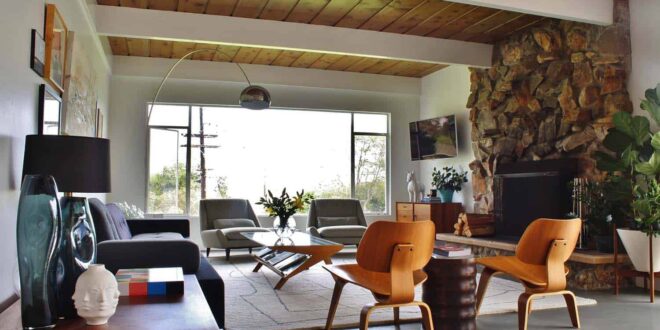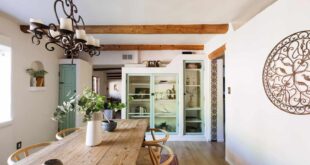
Mid-Century Modern: A Timeless Design Movement
Mid-century modern design, a style that emerged in the mid-20th century, continues to captivate and influence contemporary aesthetics. Characterized by clean lines, organic shapes, and a focus on functionality, mid-century modern seamlessly blends form and function. This article delves into the origins, key characteristics, influential figures, and enduring appeal of mid-century modern design, examining its impact on furniture, architecture, and interior design.
The Origins of Mid-Century Modern
The mid-century modern movement gained momentum in the post-World War II era, roughly spanning from the 1940s to the 1960s. This period saw a confluence of factors that contributed to the rise of this distinct design style. The end of the war brought about a sense of optimism and a desire for a fresh start, influencing designers to move away from the ornate and traditional styles of the past. The rise of mass production and new materials, such as plywood, fiberglass, and plastic, also played a crucial role in shaping the mid-century modern aesthetic. These materials allowed for greater flexibility in design and made furniture more accessible to a wider audience.
Furthermore, the influence of European modernist movements, such as Bauhaus, cannot be overstated. Many European designers and architects immigrated to the United States during the war, bringing with them their innovative ideas and design philosophies. These influences, combined with American ingenuity and a desire for modern living, gave birth to the mid-century modern style.
Key Characteristics of Mid-Century Modern Design
Several defining characteristics distinguish mid-century modern design from other styles:
- Clean Lines and Simplicity: Mid-century modern furniture and architecture emphasize clean lines, geometric shapes, and a lack of ornamentation. The focus is on functionality and the inherent beauty of the materials used.
- Organic Shapes: While clean lines are prominent, mid-century modern also incorporates organic shapes and curves, often inspired by nature. This juxtaposition of geometric and organic forms creates a sense of balance and harmony.
- Functionality: Mid-century modern design prioritizes functionality and practicality. Furniture is designed to be comfortable, durable, and easy to use. Spaces are designed to be efficient and conducive to modern living.
- Use of New Materials: The movement embraced new materials such as plywood, fiberglass, plastic, and aluminum, which allowed for greater experimentation and innovation in design.
- Integration with Nature: Mid-century modern architecture often features large windows, open floor plans, and a connection to the outdoors. The goal is to bring natural light and ventilation into the home and to create a seamless transition between indoor and outdoor spaces. [See also: Sustainable Design Principles]
- Minimalism: A core principle of mid-century modern is minimalism, advocating for decluttered spaces with essential furniture and décor that serve a purpose.
Influential Figures in Mid-Century Modern Design
Numerous designers and architects played a pivotal role in shaping the mid-century modern movement. Some of the most influential figures include:
- Charles and Ray Eames: Known for their iconic furniture designs, such as the Eames Lounge Chair and the Eames Molded Plastic Chair, Charles and Ray Eames revolutionized furniture design with their innovative use of materials and their focus on comfort and functionality.
- Eero Saarinen: A Finnish-American architect and designer, Eero Saarinen is famous for his organic and sculptural designs, such as the Tulip Chair and the TWA Flight Center at JFK Airport.
- George Nelson: As the design director of Herman Miller, George Nelson played a crucial role in promoting mid-century modern design. He is also known for his own designs, such as the Nelson Platform Bench and the Ball Clock.
- Isamu Noguchi: A Japanese-American artist and designer, Isamu Noguchi created sculptural furniture and lighting designs that blended Eastern and Western aesthetics. His Noguchi Coffee Table is a classic example of mid-century modern design.
- Mies van der Rohe: A German-American architect, Mies van der Rohe is renowned for his minimalist and functional designs, such as the Farnsworth House and the Seagram Building. His famous quote, “Less is more,” encapsulates the essence of mid-century modern design.
Mid-Century Modern Furniture
Mid-century modern furniture is characterized by its clean lines, organic shapes, and use of materials such as wood, metal, and upholstery. Common features include tapered legs, low profiles, and a focus on comfort. Iconic pieces of mid-century modern furniture include the Eames Lounge Chair, the Tulip Chair, and the Nelson Platform Bench. These pieces are not only functional but also serve as works of art.
Mid-Century Modern Architecture
Mid-century modern architecture is defined by its open floor plans, large windows, and integration with nature. Common features include flat roofs, post-and-beam construction, and the use of natural materials such as wood and stone. Examples of mid-century modern architecture include the Farnsworth House and the Case Study Houses in Southern California. These buildings showcase the principles of modernism and the desire for a harmonious relationship between the built environment and the natural world. [See also: Modernist Architecture Movements]
Mid-Century Modern Interior Design
Mid-century modern interior design focuses on creating a clean, uncluttered, and functional living space. Key elements include:
- Open Floor Plans: Open floor plans create a sense of spaciousness and allow for easy flow between rooms.
- Natural Light: Large windows and skylights bring natural light into the home, creating a bright and airy atmosphere.
- Minimalist Decor: Mid-century modern interiors are typically sparsely decorated, with a focus on essential furniture and accessories.
- Bold Colors and Patterns: While minimalism is key, mid-century modern interiors often feature bold colors and patterns, such as geometric prints and vibrant hues.
- Mix of Materials: A mix of materials, such as wood, metal, glass, and upholstery, adds texture and visual interest to the space.
The Enduring Appeal of Mid-Century Modern
The mid-century modern style continues to be popular today for several reasons. Its clean lines and simple forms are timeless and versatile, making it easy to incorporate into a variety of interior design styles. The focus on functionality and comfort makes it a practical choice for modern living. The use of natural materials and the integration with nature appeal to those who seek a connection to the outdoors. Furthermore, the iconic pieces of mid-century modern furniture and architecture have become highly sought-after collectibles, adding to the style’s enduring appeal. Its adaptability allows homeowners to blend mid-century modern elements with contemporary designs, creating a unique and personalized aesthetic.
Incorporating Mid-Century Modern into Your Home
If you’re looking to incorporate mid-century modern into your home, here are a few tips:
- Start with Key Pieces: Invest in a few iconic pieces of mid-century modern furniture, such as an Eames Lounge Chair or a Noguchi Coffee Table.
- Focus on Clean Lines: Choose furniture and accessories with clean lines and simple forms.
- Embrace Natural Materials: Incorporate natural materials such as wood, leather, and wool into your design.
- Add Pops of Color: Use bold colors and patterns to add visual interest to the space.
- Keep it Simple: Avoid clutter and focus on essential furniture and accessories.
Conclusion
Mid-century modern design is a timeless and versatile style that continues to influence contemporary aesthetics. Its clean lines, organic shapes, and focus on functionality make it a practical and appealing choice for modern living. By understanding the origins, key characteristics, and influential figures of the movement, you can appreciate its enduring legacy and incorporate its principles into your own home. The enduring appeal of mid-century modern lies in its blend of simplicity, functionality, and aesthetic beauty, making it a design movement that will continue to inspire for generations to come. Whether you’re a seasoned design enthusiast or just beginning to explore different styles, mid-century modern offers a wealth of inspiration and timeless elegance.
 Nimila
Nimila




